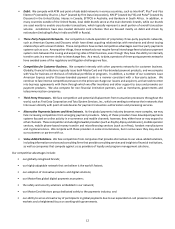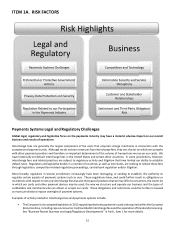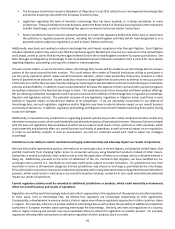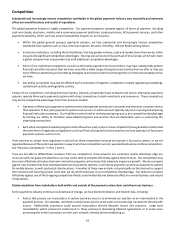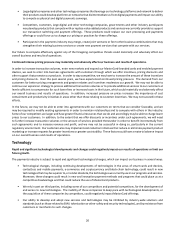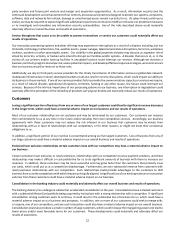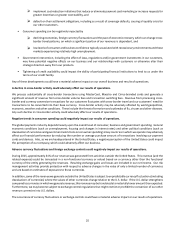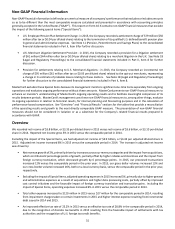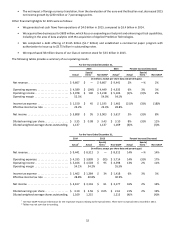MasterCard 2015 Annual Report Download - page 28
Download and view the complete annual report
Please find page 28 of the 2015 MasterCard annual report below. You can navigate through the pages in the report by either clicking on the pages listed below, or by using the keyword search tool below to find specific information within the annual report.22
party vendors and future joint venture and merger and acquisition opportunities. As a result, information security and the
continued development and enhancement of our controls, processes and practices designed to protect our systems, computers,
software, data and networks from attack, damage or unauthorized access remain a priority for us. As cyber-threats continue to
evolve, we may be required to expend significant additional resources to continue to modify or enhance our protective measures
or to investigate and remediate any information security vulnerabilities. Any of the risks described above could materially
adversely affect our overall business and results of operations.
Service disruptions that cause us to be unable to process transactions or service our customers could materially affect our
results of operations.
Our transaction processing systems and other offerings may experience interruptions as a result of a disaster, including, but not
limited to, technology malfunctions, fire, weather events, power outages, telecommunications disruptions, terrorism, workplace
violence, accidents or other catastrophic events. Our visibility in the global payments industry may also put us at greater risk of
attack by terrorists, activists, or hackers who intend to disrupt our facilities and/or systems. A disaster that occurs at, or in the
vicinity of, our primary and/or back-up facilities in any global location could interrupt our services. Although we maintain a
business continuity program to analyze risk, assess potential impacts, and develop effective response strategies, we cannot ensure
that our business would be immune to these risks.
Additionally, we rely on third-party service providers for the timely transmission of information across our global data network.
Inadequate infrastructure in lesser-developed markets could also result in service disruptions, which could impact our ability to
do business in those markets. If one of our service providers fails to provide the communications capacity or services we require,
as a result of natural disaster, operational disruptions, terrorism, hacking or any other reason, the failure could interrupt our
services. Because of the intrinsic importance of our processing systems to our business, any interruption or degradation could
adversely affect the perception of the reliability of products carrying our brands and materially reduce our results of operations.
Customers
Losing a significant portion of business from one or more of our largest customers could lead to significant revenue decreases
in the longer term, which could have a material adverse impact on our business and our results of operations.
Most of our customer relationships are not exclusive and may be terminated by our customers. Our customers can reassess
their commitments to us at any time in the future and/or develop their own competitive services. Accordingly, our business
agreements with these customers may not reduce the risk inherent in our business that customers may terminate their
relationships with us in favor of relationships with our competitors, or for other reasons, or might not meet their contractual
obligations to us.
In addition, a significant portion of our revenue is concentrated among our five largest customers. Loss of business from any of
our large customers could have a material adverse impact on our overall business and results of operations.
Exclusive/near exclusive relationships certain customers have with our competitors may have a material adverse impact on
our business.
Certain customers have exclusive, or nearly-exclusive, relationships with our competitors to issue payment products, and these
relationships may make it difficult or cost-prohibitive for us to do significant amounts of business with them to increase our
revenues. In addition, these customers may be more successful and may grow faster than the customers that primarily issue
our cards, which could put us at a competitive disadvantage. Furthermore, we earn substantial revenue from customers with
nearly-exclusive relationships with our competitors. Such relationships could provide advantages to the customers to shift
business from us to the competitors with which they are principally aligned. A significant loss of our existing revenue or transaction
volumes from these customers could have a material adverse impact on our business.
Consolidation in the banking industry could materially and adversely affect our overall business and results of operations.
The banking industry has undergone substantial, accelerated consolidation in the past. Consolidations have included customers
with a substantial MasterCard portfolio being acquired by institutions with a strong relationship with a competitor. If significant
consolidation among customers were to continue, it could result in the substantial loss of business for us, which could have a
material adverse impact on our business and prospects. In addition, one or more of our customers could seek to merge with,
or acquire, one of our competitors, and any such transaction could also have a material adverse impact on our overall business.
Consolidation could also produce a smaller number of large customers, which could increase their bargaining power and lead to
lower prices and/or more favorable terms for our customers. These developments could materially and adversely affect our
results of operations.


